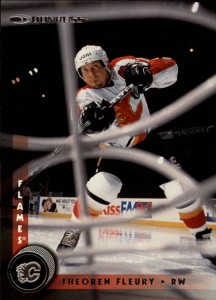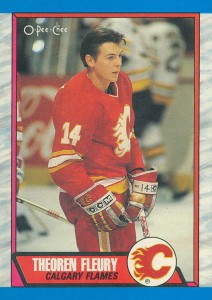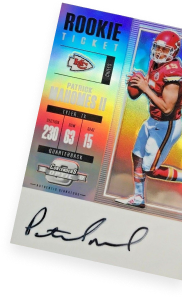Sunday Conversation: Theoren Fleury
By Stephen Laroche | Beckett Hockey Editor
While many hockey fans fondly recall the on-ice accomplishments of Theoren Fleury, his impact on people off the ice has been even more impressive.
In 2009, he revealed that he had been sexually abused by his junior hockey coach in his autobiography, Playing With Fire, and by sharing his story, he has given strength to thousands of others. In November, his newest book hit store shelves and Conversations With A Rattlesnake was written with therapist Kim Barthel, who he calls the “Wayne Gretzky of therapy.” An examination of the impact that childhood trauma has upon our lives, it is also a discussion between both authors that seeks to help and inspire others.
Fleury recently took time off from his busy touring schedule to speak with Beckett Hockey about the book and he also revealed some of his thoughts on hockey cards and memorabilia.
–
Why is the book called Conversations With A Rattlesnake?
So many people think that whenever I do something, it’s about sexual abuse. I’m not that shallow. I am constantly and continually learning so that I can help people. We started at sexual abuse, but now we’re at trauma. The whole purpose of calling the book Conversations With A Rattlesnake is that a rattlesnake sheds its skin and transforms itself and reinvents itself. I’ve looked at my life and how many times I’ve had to reinvent myself, transform myself… It is a book to inspire people to talk to one another.
–
Between you and Kim Barthel, who came up with the idea for this book?
I think it was both of us. There’s a spiritual component to how Kim and I met. I randomly showed up to this conference in Winnipeg where the two of us are both guest speakers and I’m there to speak about resilience. I get to the conference early and Kim’s giving a keynote in the afternoon. So I sit down and participate and listen and am completely blown away by the information that she was providing. The information that she was providing was family of origin trauma. Basically, the environment that I grew up in, what I saw and what I saw became learned behaviors and all of the sudden, it made sense. Because I had spoken my whole entire therapeutic process about the sexual abuse that happened to me as an adolescent, and none of my problems or any of my issues had stemmed from that. They stemmed from my early childhood, which sort of piqued my interest, so I went to get more information. When Kim was done, I went up to her and said, ‘Hey you, you just changed my life and I think you’ll be working with me for the rest of yours!’ We had dinner that night and I invited her to come to Calgary for a weekend and she came and we sat at my kitchen table and had a conversation.
At the end of that conversation, I realized that there wasn’t one thing that I could have changed all my life to make it different which then took away all of the shame that I had been carrying for many, many years and now, I had a starting point for my healing journey and my healing process.
So many people think that they can’t find the person to have this conversation with, well, I randomly got on a plane and went to Winnipeg and found Kim. It’s not that hard. When I started this journey in 2009 and you posted something on social media about sexual abuse and there would be hardly anybody responding to it. Now, it’s unbelievable! You’ve just got to put it out there.
–
The book itself is a bit unconventional as it is a dialogue between two friends with a strong focus on understanding childhood trauma. How was this process for you?
If you know anything about me, I’m not a conventional guy. The book is unconventional for many reasons. When Playing With Fire came out, I really had no idea what I was getting myself into, other than the fact that I wanted to tell my truth and hopefully just leave it in the past, get on with my life, etc.
What I quickly realized was something that I felt was uncommon is actually the most common thing that happens in the world and that is childhood trauma and childhood traumatic experiences, sexual abuse, physical abuse, emotional abuse, neglect, abandonment – the list goes on and on and on.
Little did I know that in October of 2009 that I shared the same experience as approximately 13.5 million Canadians. Not only that, but I also had over 500,000 reveals, and by reveal, I mean people telling me their stories and most times after they share that experience, the next question is ‘what do I do next?’ Because so many people think that there’s a quick fix for trauma, I have discovered that it is a life-long process of healing. That is what Conversation With A Rattlesnake is, sort of sharing my own personal self-discovery with an effort on the subject of childhood trauma and then from that, people read it which causes them to self-reflect on their own experiences, which then creates more conversation. There is no pill. There is no remedy. I wouldn’t call it a cure. I would call the release and understanding from what trauma does to you conversation.
–
Did you collect hockey cards as a child?
Oh of course, who didn’t? We obviously traded cards and when we were at hockey tournaments, we’d have a stack in our pocket. To me, I really liked the stats.
–
Do you recall the first time you saw yourself on a trading card?
I didn’t believe it. This is an incredible story. We were in Toronto the year after we won the Stanley Cup, I think it was in February. I was coming out of the hotel, I think it was the Hyatt, and I’m heading down to Maple Leaf Gardens. This kid comes up to me and asks me if I can sign his hockey card and I looked at him and I’m like ‘Hockey card? I don’t have a hockey card.’ and he says ‘Yeah, the new ones just came out and here it is!’ I thought, holy cow! He actually had an extra copy and gave me one and I signed one for him, so here I am 30 years later and there’s what, 2,000 of them? I loved seeing all those cards. It’s sort of that thing where you’ve finally made it when you have a hockey card.
–
The photo on your rookie card was taken in Boston before your ninth NHL game on January 19, 1989. Do you remember much about that 7-2 victory for the Flames?
“I think Mark Hunter scored four goals that night and Hakan Loob scored one of the sickest goals I’ve ever seen. I think he had the puck for like a minute and a half in the Bruins’ zone and beat everybody three or four times and then scored. It was unbelievable.”
–
For years, there has been a consistent demand for your autograph and you have always been regarded as a gracious signer. What are your feelings about being approached by fans for a signature?
“The way that I see it, and maybe it is a small-town mentality that I have, but quickly and early on in my career, I realized that up until I was 15 years old, I only saw one NHL game live and what I realized how important the fans are to the game of hockey or any sport and how much money it took my parents from Russell, Manitoba to buy the tickets, hotel, transportation, meals and all that stuff to take me to a game in Winnipeg to watch the Jets play. I realized without the fans doing that, wanting me to sign cards or jerseys or whatever it is, there is no NHL. I was a guy would sign anything. I didn’t care. It didn’t matter because I used to be one of those kids. I got Lanny McDonald‘s autograph and years later, we’re carrying the Stanley Cup around the Montreal Forum.
I just signed a bunch of cards that came in the mail yesterday and I sent them back. It’s amazing how many guys who come up to me and say, ‘when I was eight, I wrote to 40 different hockey players and you were the only guy who sent anything back.’ I think that’s pretty cool because he remembers it as being a highlight of his life.
–
Did you hang on to any memorabilia from your 15-year NHL career?
I have every jersey that I’ve ever worn. Other than that, I have boxes of cards all over the place because the companies would send you them, but other than that, I didn’t collect anyone else’s. I didn’t really like being ‘that guy.’ I have some Wayne Gretzky stuff, but it’s stuff he voluntarily gave me. I didn’t ask for it, but he was like that with everybody. What I have more than anything else is the memories and stories to go with them. That’s what I love the most.
–
Is there a particular piece that stands out for you?
It’s not about that. The last thing in the process that happens is that you get the medal or the ring. There’s so much more that happens before that happens, right? To me, that process of winning and now that I have all these experience and all these stories, that’s what it’s all about. That’s why we do what we do. That’s why we get out of bed every day. I tell kids, when the Zamboni leaves the ice, there’s a nice sheet of paper left for you to write a different story every 20 minutes. To me, that’s why I think a lot of us did what we did was to have those experiences and have others interpret what we did on the ice.
–
Stephen Laroche is the editor of Beckett Hockey and Beckett Basketball magazines. Have a comment, question or idea? Send an e-mail to him at SLaroche@beckett.com. Follow him on Twitter @Stephen_Laroche.










